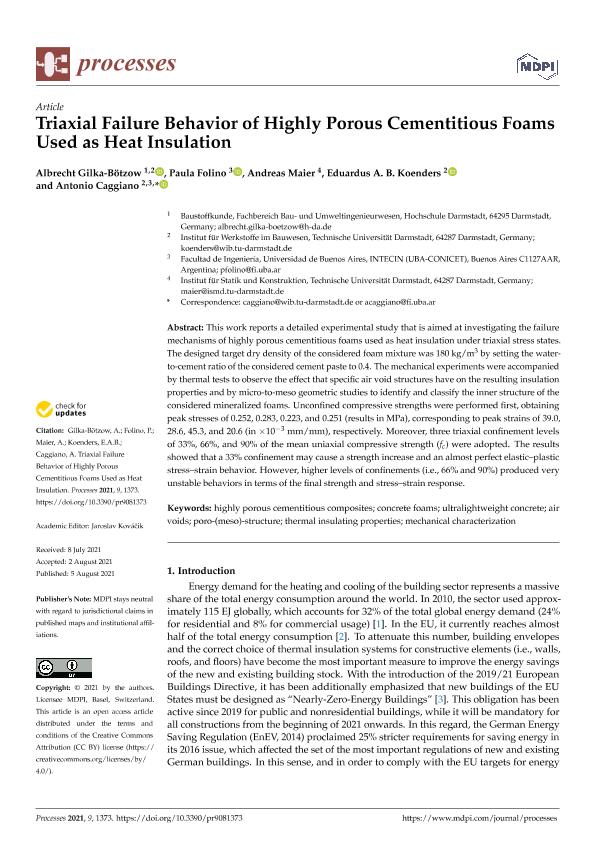Mostrar el registro sencillo del ítem
dc.contributor.author
Gilka Bötzow, Albrecht
dc.contributor.author
Folino, Paula

dc.contributor.author
Maier, Andreas
dc.contributor.author
Koenders, Eduardus A. B.
dc.contributor.author
Caggiano, Antonio

dc.date.available
2023-12-13T14:43:24Z
dc.date.issued
2021-08
dc.identifier.citation
Gilka Bötzow, Albrecht; Folino, Paula; Maier, Andreas; Koenders, Eduardus A. B.; Caggiano, Antonio; Triaxial failure behavior of highly porous cementitious foams used as heat insulation; MDPI; Processes; 9; 8; 8-2021; 1-15
dc.identifier.issn
2227-9717
dc.identifier.uri
http://hdl.handle.net/11336/220135
dc.description.abstract
This work reports a detailed experimental study that is aimed at investigating the failure mechanisms of highly porous cementitious foams used as heat insulation under triaxial stress states. The designed target dry density of the considered foam mixture was 180 kg/m3 by setting the water-to-cement ratio of the considered cement paste to 0.4. The mechanical experiments were accompanied by thermal tests to observe the effect that specific air void structures have on the resulting insulation properties and by micro-to-meso geometric studies to identify and classify the inner structure of the considered mineralized foams. Unconfined compressive strengths were performed first, obtaining peak stresses of 0.252, 0.283, 0.223, and 0.251 (results in MPa), corresponding to peak strains of 39.0, 28.6, 45.3, and 20.6 (in ×10−3 mm/mm), respectively. Moreover, three triaxial confinement levels of 33%, 66%, and 90% of the mean uniaxial compressive strength (fc) were adopted. The results showed that a 33% confinement may cause a strength increase and an almost perfect elastic–plastic stress–strain behavior. However, higher levels of confinements (i.e., 66% and 90%) produced very unstable behaviors in terms of the final strength and stress–strain response.
dc.format
application/pdf
dc.language.iso
eng
dc.publisher
MDPI
dc.rights
info:eu-repo/semantics/openAccess
dc.rights.uri
https://creativecommons.org/licenses/by/2.5/ar/
dc.subject
AIR VOIDS
dc.subject
CONCRETE FOAMS
dc.subject
HIGHLY POROUS CEMENTITIOUS COMPOSITES
dc.subject
MECHANICAL CHARACTERIZATION
dc.subject
PORO-(MESO)-STRUCTURE
dc.subject
THERMAL INSULATING PROPERTIES
dc.subject
ULTRALIGHTWEIGHT CONCRETE
dc.subject.classification
Ingeniería Estructural

dc.subject.classification
Ingeniería Civil

dc.subject.classification
INGENIERÍAS Y TECNOLOGÍAS

dc.subject.classification
Otras Ingeniería de los Materiales

dc.subject.classification
Ingeniería de los Materiales

dc.subject.classification
INGENIERÍAS Y TECNOLOGÍAS

dc.title
Triaxial failure behavior of highly porous cementitious foams used as heat insulation
dc.type
info:eu-repo/semantics/article
dc.type
info:ar-repo/semantics/artículo
dc.type
info:eu-repo/semantics/publishedVersion
dc.date.updated
2023-12-12T13:20:30Z
dc.journal.volume
9
dc.journal.number
8
dc.journal.pagination
1-15
dc.journal.pais
Suiza

dc.journal.ciudad
Basel
dc.description.fil
Fil: Gilka Bötzow, Albrecht. Universitat Technische Darmstadt; Alemania
dc.description.fil
Fil: Folino, Paula. Universidad de Buenos Aires. Facultad de Ingeniería; Argentina
dc.description.fil
Fil: Maier, Andreas. Universitat Technische Darmstadt; Alemania
dc.description.fil
Fil: Koenders, Eduardus A. B.. Universitat Technische Darmstadt; Alemania
dc.description.fil
Fil: Caggiano, Antonio. Universidad de Buenos Aires. Facultad de Ingeniería; Argentina. Consejo Nacional de Investigaciones Científicas y Técnicas. Oficina de Coordinación Administrativa Houssay. Instituto de Tecnologías y Ciencias de la Ingeniería "Hilario Fernández Long". Universidad de Buenos Aires. Facultad de Ingeniería. Instituto de Tecnologías y Ciencias de la Ingeniería "Hilario Fernández Long"; Argentina
dc.journal.title
Processes
dc.relation.alternativeid
info:eu-repo/semantics/altIdentifier/url/https://www.mdpi.com/2227-9717/9/8/1373
dc.relation.alternativeid
info:eu-repo/semantics/altIdentifier/doi/http://dx.doi.org/10.3390/pr9081373
Archivos asociados
